Leading teksturovschik cartoon "Rango" - Steve Walton, gave some inspiring numbers: to create animation ILM (Studio 3D and 2D special effects) had to render:
- 130 characters;
- 1 yew. inventory items;
- 37 facilities;
- 28 tis. various clothing items;
- A huge number of stones, the smallest gravel, lots of rocks, grass and cacti;
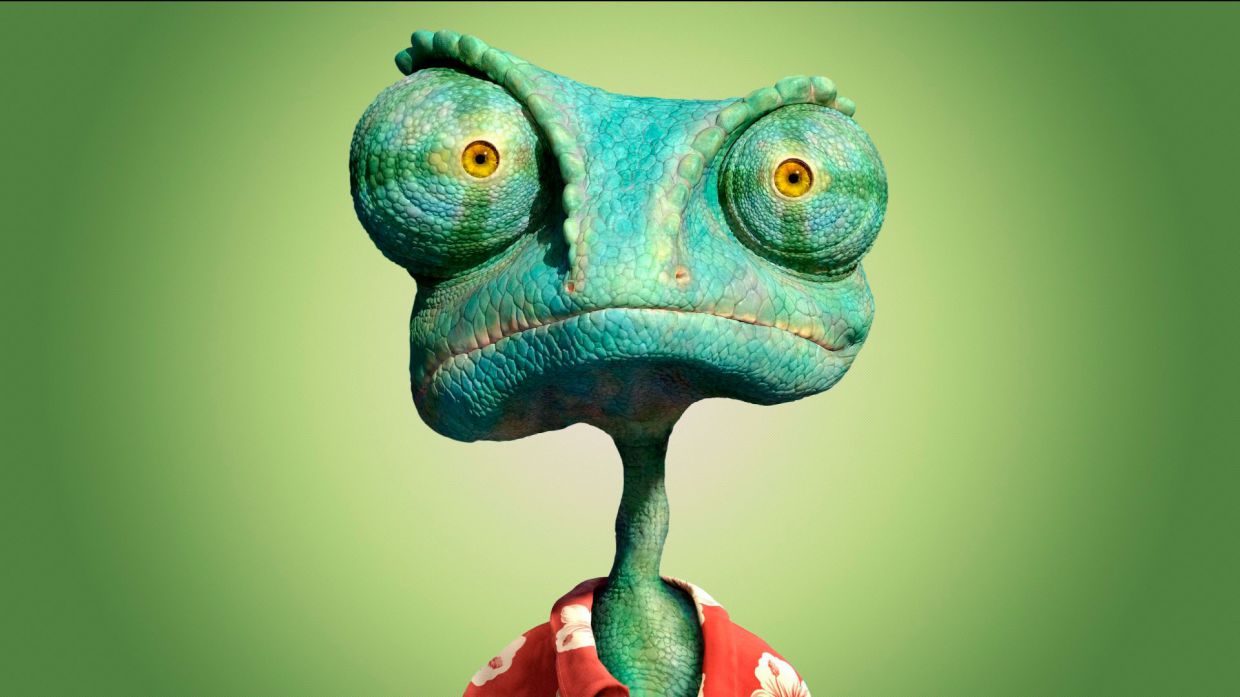
All this has been drawn in over 2.5 years. During this period, he ran Walton group of professional artists, which eventually amounted to 20 people. They provide the desired imaging scorched sand on the characters and buildings. In order to get the desired stream from artists had their own room, obstavlenaaya cacti and pasted posters of various Westerns are also very helping writers.
If the artist is not enough clarification from B & # 1077; rbinski or innovative ideas from McCrery, the director found his own path to explain to them the idea. Explanations director were as different sounds, change your voice to a gruff cowboy tone, he uttered a loud "rrrrrrehhhho." And so there is an image of the future rank.
To create a digital picture of all explanations, descriptions and exclamations, Walton worked closely with the Director for Technical Issues - Damian A.Still who was involved in materials and was responsible for the look of the characters. He took out various outfits of clothes studio Universal. For artists, it was important to see small features: various specks of dirt or sweat - it helped to feel and understand how it should look like the material for clothing.
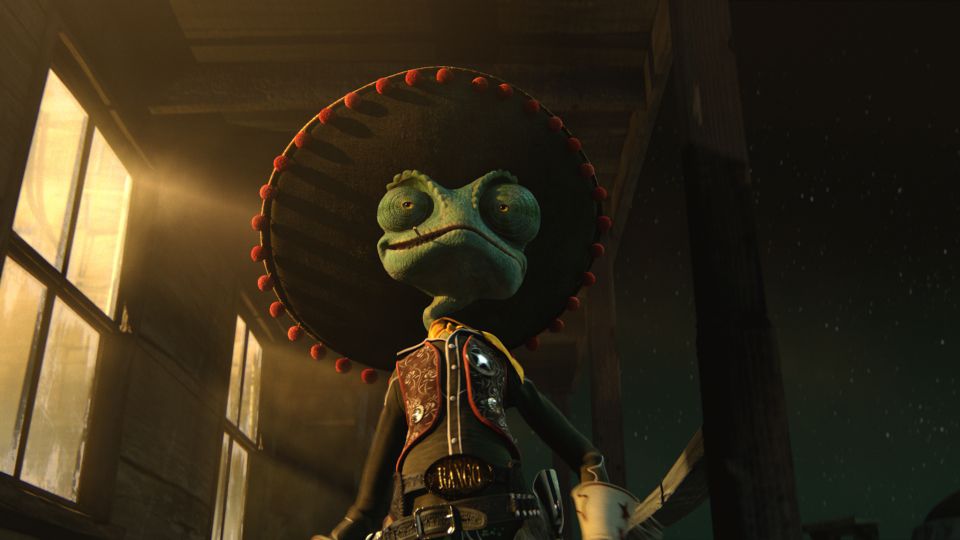
The critic Richard Corliss praised the work of the team ILM. He said that created a desert landscape looks absolutely realistic, and the entire cartoon is like a live film footage. The surface of the skin of reptiles, scaly, and slightly messy hair rodent look very realistic, and these creatures do not want to touch.
Almost all the characters were dressed in different clothes. The rank of constant change it, since it is always something happening and often soiled his clothes. A constant change of clothes for the characters - a unique case in the creation of cartoons. Artists had to respond appropriately to all the action Rango, rather than just once a cartoon character.
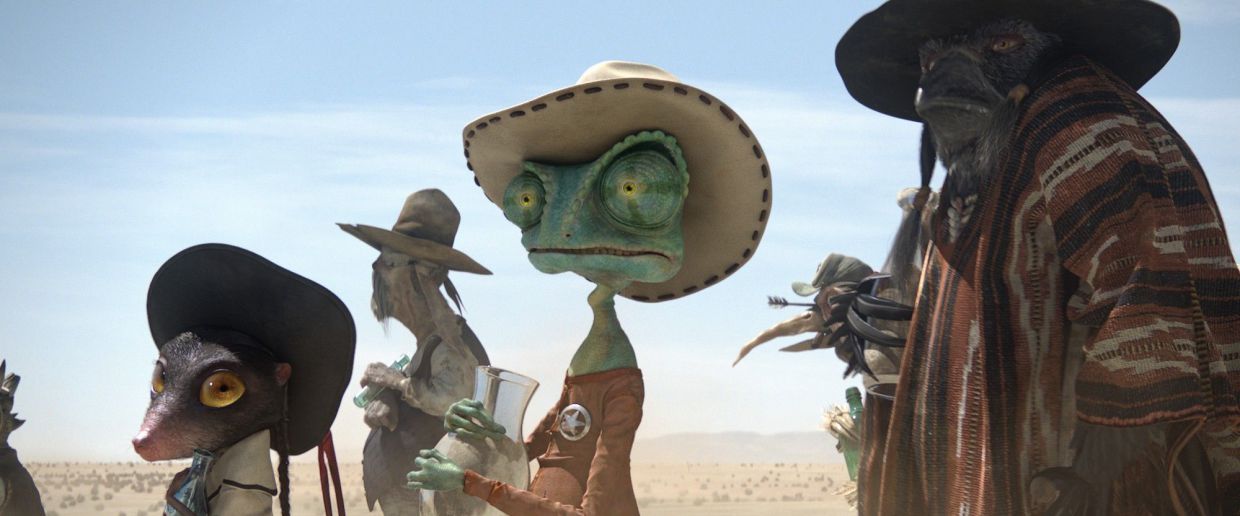
Features leather Rango created designer Frank Krevet. To draw convexity and scales he used the technique of displacement using ZBrush. After that, Walton, using black and white texture, improved image through specifying details.
They were built shader RenderMan'a and responsible for particular surface created: translucent surface, subsurface scattering and reflection.
The cartoon was used a huge amount of textures:
- About 120 textures to create effects;
- 20 color texture of just one character (the texture changed in accordance with what was happening with the rank).
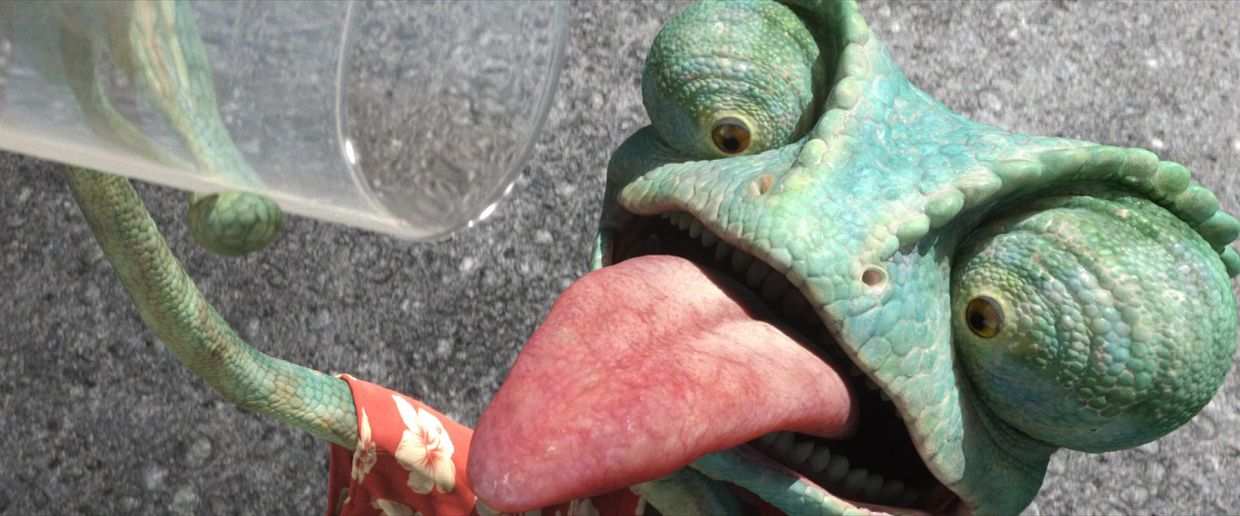
Chief teksturovschik invented its strategy for the storage of such a large number of textures and he tried to share it with the maximum number of artists. With so many textures, needed a complete certainty what the correct texture will be applied in the corresponding episode. Therefore, each texture were pasted telephone numbers to clarify the details. In general, the work on the appearance of the characters lasted one year. Artists experimented - made images of thick, rough, shabby, sun-scorched.
How did the animation, "Rango"
Kevin Martel began his career as an animator at ILM characters in the first episode of "Star Warrior". A little later, he was in a group of professional animators under the direction of Hal Hiskela and worked on all parts of the film "Pirates of the Caribbean." When you create a project "Rango", Martel became the leading animator of the protagonist, and in the end the project was promoted to the honorary head of the animation.
The essence of the scene showed a video storyboard acting Johnny Depp in the role of protagonist. It was he who gave the image of Rango physical execution and the expression of the eyes. Watching him, animators worked through immediately impressed that should produce rank.
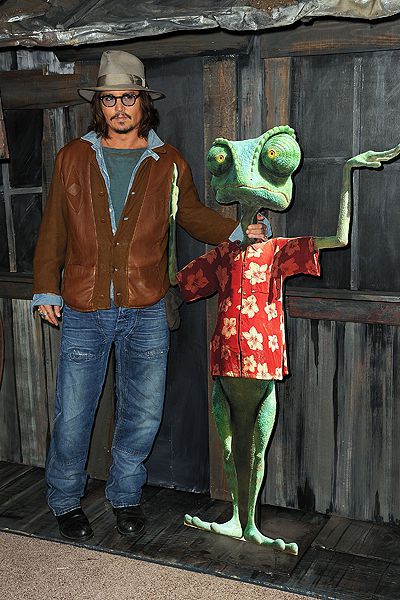
Martel spent much time meditating, studying and sketching the details, and only then sat down at the keyboard. Work at the computer began with the placement of the low poly shape reptiles in different poses. Throwing the key positions, he quickly recorded their ideas, because clarity poses for him - the main part of the animation cartoon.
Following the approval of the main positions and actions animator began to develop a high poly model to modify the behavior of the character and the look on his face. This part of the animation was the most time-consuming, because Rango large enough range of emotions. Pupils reptile small, but it has a lot of wrinkles and folds moving, which can be controlled using otmodelirovannyh forms. In total there are more than 300 options for changing these folds attractive face on the main character.
Several interesting features
Virtually all parts needed to animate manually. Even the camera is in different positions, and all the time change their location, and the response to any movement and vibration. The multi use virtual camera. Of course, to achieve the desired effect made finishing by hand, so on with the result still should work hard.
Especially for the project has formed a separate team "render triage" (sequencing render support), their job was to sort the difficult moments that happened in the visual display of the cartoon. Man sent to the team, if he could not cope with a certain scene within the hour. And such action accelerates and facilitates the work, as technical directors often worked with such scenes, which were about thirty characters, and they all had a lot of details: hairs, feathers, especially in different clothes.
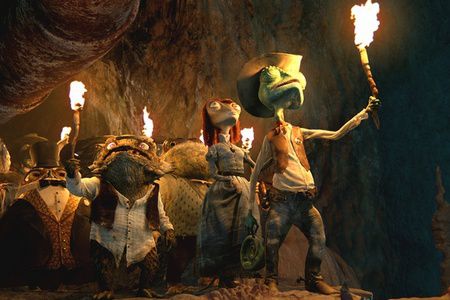
The lighting in the 3d-animation
Company ILM does not complicate a job scripts for color correction, faced skilled in creating CG-animated cartoons. Instead, everything was done in such a way as it is supposed to create special effects for real films. It was specially assembled set of all necessary technical equipment for lighting, and technical directors may at any momk
If the artist is not enough clarification from Verbinski and innovative ideas from McCrery, the director found his own path to explain to them the idea. Explanations director were as different sounds, change your voice to a gruff cowboy tone, he uttered a loud "rrrrrrehhhho." And so there is an image of the future rank.
To create a digital picture of all explanations, descriptions and exclamations, Walton worked closely with the Director for Technical Issues - Damian A.Still who was involved in materials and was responsible for the look of the characters. He took out various outfits of clothes studio Universal. For artists, it was important to see small features: various specks of dirt or sweat - it helped to feel and understand how it should look like the material for clothing.

The critic Richard Corliss praised the work of the team ILM. He said that created a desert landscape looks absolutely realistic, and the entire cartoon is like a live film footage. The surface of the skin of reptiles, scaly, and slightly messy hair rodent look very realistic, and these creatures do not want to touch.
Almost all the characters were dressed in different clothes. The rank of constant change it, since it is always something happening and often soiled his clothes. A constant change of clothes for the characters - a unique case in the creation of cartoons. Artists had to respond appropriately to all the action Rango, rather than just once a cartoon character.

Features leather Rango created designer Frank Krevet. To draw convexity and scales he used the technique of displacement using ZBrush. After that, Walton, using black and white texture, improved image through specifying details.
They were built shader RenderMan'a and responsible for particular surface created: translucent surface, subsurface scattering and reflection.
The cartoon was used a huge amount of textures:
- About 120 textures to create effects;
- 20 color texture of just one character (the texture changed in accordance with what was happening with the rank).

Chief teksturovschik invented its strategy for the storage of such a large number of textures and he tried to share it with the maximum number of artists. With so many textures, needed a complete certainty what the correct texture will be applied in the corresponding episode. Therefore, each texture were pasted telephone numbers to clarify the details. In general, the work on the appearance of the characters lasted one year. Artists experimented - made images of thick, rough, shabby, sun-scorched.
How did the animation, "Rango"
Kevin Martel began his career as an animator at ILM characters in the first episode of "Star Warrior". A little later, he was in a group of professional animators under the direction of Hal Hiskela and worked on all parts of the film "Pirates of the Caribbean." When you create a project "Rango", Martel became the leading animator of the protagonist, and in the end the project was promoted to the honorary head of the animation.
The essence of the scene showed a video storyboard acting Johnny Depp in the role of protagonist. It was he who gave the image of Rango physical execution and the expression of the eyes. Watching him, animators worked through immediately impressed that should produce rank.

Martel spent much time meditating, studying and sketching the details, and only then sat down at the keyboard. Work at the computer began with the placement of the low poly shape reptiles in different poses. Throwing the key positions, he quickly recorded their ideas, because clarity poses for him - the main part of the animation cartoon.
Following the approval of the main positions and actions animator began to develop a high poly model to modify the behavior of the character and the look on his face. This part of the animation was the most time-consuming, because Rango large enough range of emotions. Pupils reptile small, but it has a lot of wrinkles and folds moving, which can be controlled using otmodelirovannyh forms. In total there are more than 300 options for changing these folds attractive face on the main character.
Several interesting features
Virtually all parts needed to animate manually. Even the camera is in different positions, and all the time change their location, and the response to any movement and vibration. The multi use virtual camera. Of course, to achieve the desired effect made finishing by hand, so on with the result still should work hard.
Especially for the project has formed a separate team "render triage" (sequencing render support), their job was to sort the difficult moments that happened in the visual display of the cartoon. Man sent to the team, if he could not cope with a certain scene within the hour. And such action accelerates and facilitates the work, as technical directors often worked with such scenes, which were about thirty characters, and they all had a lot of details: hairs, feathers, especially in different clothes.

The lighting in the 3d-animation
Company ILM does not complicate a job scripts for color correction, faced skilled in creating CG-animated cartoons. Instead, everything was done in such a way as it is supposed to create special effects for real films. It was specially assembled set of all necessary technical equipment for lighting, and technical directors may at any time change lighting scenes while you work.
- 130 characters;
- 1 yew. inventory items;
- 37 facilities;
- 28 tis. various clothing items;
- A huge number of stones, the smallest gravel, lots of rocks, grass and cacti;

All this has been drawn in over 2.5 years. During this period, he ran Walton group of professional artists, which eventually amounted to 20 people. They provide the desired imaging scorched sand on the characters and buildings. In order to get the desired stream from artists had their own room, obstavlenaaya cacti and pasted posters of various Westerns are also very helping writers.
If the artist is not enough clarification from B & # 1077; rbinski or innovative ideas from McCrery, the director found his own path to explain to them the idea. Explanations director were as different sounds, change your voice to a gruff cowboy tone, he uttered a loud "rrrrrrehhhho." And so there is an image of the future rank.
To create a digital picture of all explanations, descriptions and exclamations, Walton worked closely with the Director for Technical Issues - Damian A.Still who was involved in materials and was responsible for the look of the characters. He took out various outfits of clothes studio Universal. For artists, it was important to see small features: various specks of dirt or sweat - it helped to feel and understand how it should look like the material for clothing.

The critic Richard Corliss praised the work of the team ILM. He said that created a desert landscape looks absolutely realistic, and the entire cartoon is like a live film footage. The surface of the skin of reptiles, scaly, and slightly messy hair rodent look very realistic, and these creatures do not want to touch.
Almost all the characters were dressed in different clothes. The rank of constant change it, since it is always something happening and often soiled his clothes. A constant change of clothes for the characters - a unique case in the creation of cartoons. Artists had to respond appropriately to all the action Rango, rather than just once a cartoon character.

Features leather Rango created designer Frank Krevet. To draw convexity and scales he used the technique of displacement using ZBrush. After that, Walton, using black and white texture, improved image through specifying details.
They were built shader RenderMan'a and responsible for particular surface created: translucent surface, subsurface scattering and reflection.
The cartoon was used a huge amount of textures:
- About 120 textures to create effects;
- 20 color texture of just one character (the texture changed in accordance with what was happening with the rank).

Chief teksturovschik invented its strategy for the storage of such a large number of textures and he tried to share it with the maximum number of artists. With so many textures, needed a complete certainty what the correct texture will be applied in the corresponding episode. Therefore, each texture were pasted telephone numbers to clarify the details. In general, the work on the appearance of the characters lasted one year. Artists experimented - made images of thick, rough, shabby, sun-scorched.
How did the animation, "Rango"
Kevin Martel began his career as an animator at ILM characters in the first episode of "Star Warrior". A little later, he was in a group of professional animators under the direction of Hal Hiskela and worked on all parts of the film "Pirates of the Caribbean." When you create a project "Rango", Martel became the leading animator of the protagonist, and in the end the project was promoted to the honorary head of the animation.
The essence of the scene showed a video storyboard acting Johnny Depp in the role of protagonist. It was he who gave the image of Rango physical execution and the expression of the eyes. Watching him, animators worked through immediately impressed that should produce rank.

Martel spent much time meditating, studying and sketching the details, and only then sat down at the keyboard. Work at the computer began with the placement of the low poly shape reptiles in different poses. Throwing the key positions, he quickly recorded their ideas, because clarity poses for him - the main part of the animation cartoon.
Following the approval of the main positions and actions animator began to develop a high poly model to modify the behavior of the character and the look on his face. This part of the animation was the most time-consuming, because Rango large enough range of emotions. Pupils reptile small, but it has a lot of wrinkles and folds moving, which can be controlled using otmodelirovannyh forms. In total there are more than 300 options for changing these folds attractive face on the main character.
Several interesting features
Virtually all parts needed to animate manually. Even the camera is in different positions, and all the time change their location, and the response to any movement and vibration. The multi use virtual camera. Of course, to achieve the desired effect made finishing by hand, so on with the result still should work hard.
Especially for the project has formed a separate team "render triage" (sequencing render support), their job was to sort the difficult moments that happened in the visual display of the cartoon. Man sent to the team, if he could not cope with a certain scene within the hour. And such action accelerates and facilitates the work, as technical directors often worked with such scenes, which were about thirty characters, and they all had a lot of details: hairs, feathers, especially in different clothes.

The lighting in the 3d-animation
Company ILM does not complicate a job scripts for color correction, faced skilled in creating CG-animated cartoons. Instead, everything was done in such a way as it is supposed to create special effects for real films. It was specially assembled set of all necessary technical equipment for lighting, and technical directors may at any momk
If the artist is not enough clarification from Verbinski and innovative ideas from McCrery, the director found his own path to explain to them the idea. Explanations director were as different sounds, change your voice to a gruff cowboy tone, he uttered a loud "rrrrrrehhhho." And so there is an image of the future rank.
To create a digital picture of all explanations, descriptions and exclamations, Walton worked closely with the Director for Technical Issues - Damian A.Still who was involved in materials and was responsible for the look of the characters. He took out various outfits of clothes studio Universal. For artists, it was important to see small features: various specks of dirt or sweat - it helped to feel and understand how it should look like the material for clothing.

The critic Richard Corliss praised the work of the team ILM. He said that created a desert landscape looks absolutely realistic, and the entire cartoon is like a live film footage. The surface of the skin of reptiles, scaly, and slightly messy hair rodent look very realistic, and these creatures do not want to touch.
Almost all the characters were dressed in different clothes. The rank of constant change it, since it is always something happening and often soiled his clothes. A constant change of clothes for the characters - a unique case in the creation of cartoons. Artists had to respond appropriately to all the action Rango, rather than just once a cartoon character.

Features leather Rango created designer Frank Krevet. To draw convexity and scales he used the technique of displacement using ZBrush. After that, Walton, using black and white texture, improved image through specifying details.
They were built shader RenderMan'a and responsible for particular surface created: translucent surface, subsurface scattering and reflection.
The cartoon was used a huge amount of textures:
- About 120 textures to create effects;
- 20 color texture of just one character (the texture changed in accordance with what was happening with the rank).

Chief teksturovschik invented its strategy for the storage of such a large number of textures and he tried to share it with the maximum number of artists. With so many textures, needed a complete certainty what the correct texture will be applied in the corresponding episode. Therefore, each texture were pasted telephone numbers to clarify the details. In general, the work on the appearance of the characters lasted one year. Artists experimented - made images of thick, rough, shabby, sun-scorched.
How did the animation, "Rango"
Kevin Martel began his career as an animator at ILM characters in the first episode of "Star Warrior". A little later, he was in a group of professional animators under the direction of Hal Hiskela and worked on all parts of the film "Pirates of the Caribbean." When you create a project "Rango", Martel became the leading animator of the protagonist, and in the end the project was promoted to the honorary head of the animation.
The essence of the scene showed a video storyboard acting Johnny Depp in the role of protagonist. It was he who gave the image of Rango physical execution and the expression of the eyes. Watching him, animators worked through immediately impressed that should produce rank.

Martel spent much time meditating, studying and sketching the details, and only then sat down at the keyboard. Work at the computer began with the placement of the low poly shape reptiles in different poses. Throwing the key positions, he quickly recorded their ideas, because clarity poses for him - the main part of the animation cartoon.
Following the approval of the main positions and actions animator began to develop a high poly model to modify the behavior of the character and the look on his face. This part of the animation was the most time-consuming, because Rango large enough range of emotions. Pupils reptile small, but it has a lot of wrinkles and folds moving, which can be controlled using otmodelirovannyh forms. In total there are more than 300 options for changing these folds attractive face on the main character.
Several interesting features
Virtually all parts needed to animate manually. Even the camera is in different positions, and all the time change their location, and the response to any movement and vibration. The multi use virtual camera. Of course, to achieve the desired effect made finishing by hand, so on with the result still should work hard.
Especially for the project has formed a separate team "render triage" (sequencing render support), their job was to sort the difficult moments that happened in the visual display of the cartoon. Man sent to the team, if he could not cope with a certain scene within the hour. And such action accelerates and facilitates the work, as technical directors often worked with such scenes, which were about thirty characters, and they all had a lot of details: hairs, feathers, especially in different clothes.

The lighting in the 3d-animation
Company ILM does not complicate a job scripts for color correction, faced skilled in creating CG-animated cartoons. Instead, everything was done in such a way as it is supposed to create special effects for real films. It was specially assembled set of all necessary technical equipment for lighting, and technical directors may at any time change lighting scenes while you work.


 The Combination Of The Floor And Walls In The Interior
The Combination Of The Floor And Walls In The Interior
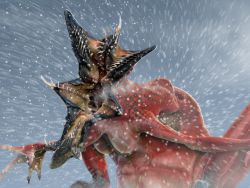 Neville Page And His Creations
Neville Page And His Creations
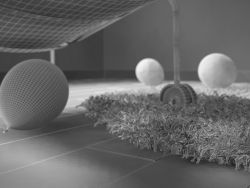 What Is Rendering
What Is Rendering
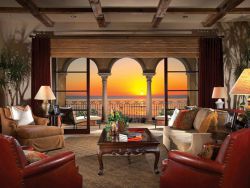 The Identity Of The Italian Interior
The Identity Of The Italian Interior
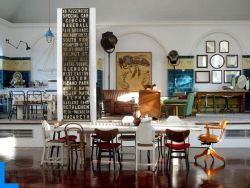 Eclecticism: The Union Of Opposites
Eclecticism: The Union Of Opposites